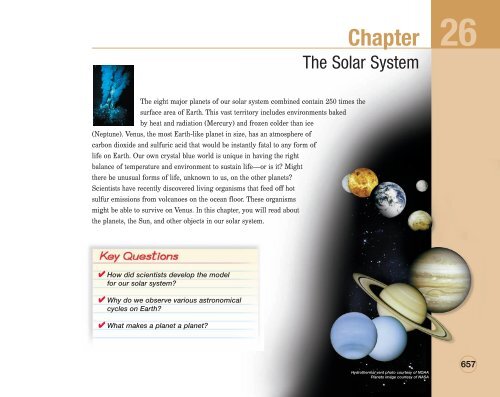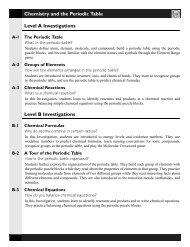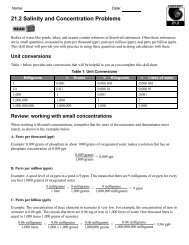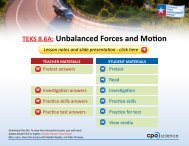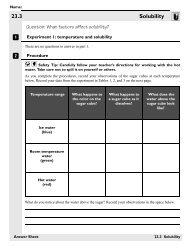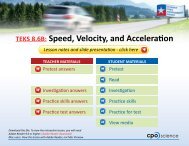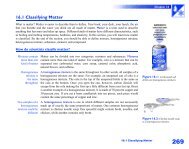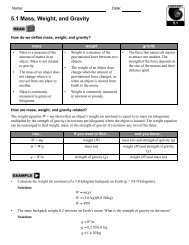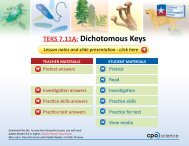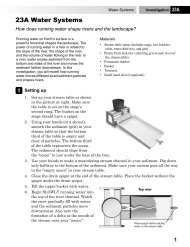Student Edition Sample Chapter (2.8MB PDF) - CPO Science
Student Edition Sample Chapter (2.8MB PDF) - CPO Science
Student Edition Sample Chapter (2.8MB PDF) - CPO Science
You also want an ePaper? Increase the reach of your titles
YUMPU automatically turns print PDFs into web optimized ePapers that Google loves.
THE SOLAR SYSTEM <strong>Chapter</strong> 26The current model of the solar systemThe discovery oftwo additionalplanetsSolar systemdefinitionAt the time of Copernicus and Galileo, astronomers thought that there wereonly six planets: Mercury, Venus, Earth, Mars, Jupiter, and Saturn. The distantplanets Uranus and Neptune are far from the Sun and don’t reflect much lightback to Earth. These planets were not discovered until telescopes becamepowerful enough to see very faint objects.Today, we define the solar system as the Sun and all objects that are boundby gravitational force to the Sun. The gravitational force of the Sun keeps thesolar system together just as gravity keeps the Moon in orbit around Earth.The solar system includes eight major planets and their moons, and a largenumber of smaller objects (dwarf planets, asteroids, comets, and meteors).solar system - the Sun and allobjects that are bound by gravitationalforce to the Sun.The orbits of the planets are not truecircles, but ellipses. An ellipse isshaped like an oval. While the actualpaths are nearly true circles, the Sunis not at the center, but is off slightly toone side. For example, Mercury’s orbitis shifted 21 percent to one side of theSun.Inner and outerplanetsThe solar system is roughly divided into the inner planets (Mercury, Venus,Earth, and Mars) and the outer planets (Jupiter, Saturn, Uranus, and Neptune).The dwarf planet Pluto is the oldest known member of a smaller group offrozen worlds orbiting beyond Neptune. The diagram above shows the orbitsof the planets (the planets are not shown to scale). Notice that Neptune isfarther from the Sun than the dwarf planet Pluto over part of Neptune’s orbit.26.1 MOTION AND THE SOLAR SYSTEM663
THE SOLAR SYSTEM <strong>Chapter</strong> 26Motion and keeping track of timeCalendarsYears and daysLeap yearsThe time of dayModern clocksA calendar is a means of keeping track of all the days in a year. Ancientcivilizations developed calendars based on their observations of the Sun,Moon, and stars. Many such civilizations independently invented almostidentical calendars. (See the sidebar at the right).Recall that one year is the amount of time it takes Earth to complete onerevolution around the Sun. This is approximately 365.25 days. Each day isone rotation of Earth on its axis. Since Earth spins from west to east, the Sunappears to travel across the sky from east to west. Ancient observers thoughtthat the Sun really did move across the sky. Can you see why?The ancient Egyptian calendar described in the sidebar added up to 365 daysand eventually evolved into the calendar we use today. However, because weknow that one year is approximately 365.25 days long, our calendar adjusts forthis. It has eleven months with 30 or 31 days each, and one month—February—with 28 days. In a leap year, February has 29 days. The extra day every fouryears makes up for the extra 0.25 day that occurs each year.A clock is a device that is used to mark the division of the day into equal parts(Figure 26.11). The sundial is the oldest known “clock.” A sundial uses theshadow of a pointer that moves from one side of the base to the other as theSun appears to travel from east to west during the day. Markers are placedaround the base to determine the hour. Water clocks were stone containerswith sloping sides that allowed water to drip at a constant rate through a smallhole in the bottom. Markings on the inside surface of the container measuredthe passage of “hours.”Today, we divide each rotation of Earth into 24 equal parts called hours. Eachhour is divided up into 60 parts called minutes and each minute into 60 partscalled seconds. Like the water clock, modern clocks use a constant, repetitiveaction or process to keep track of equal increments of time. Where the waterclock used the constant dripping of water, modern clocks use a pendulum,vibrating crystal, balance wheel, electromagnetic waves, or even atoms tomark time.Calendars Throughout History7,000 BCE. Babylonians kept acalendar with 29- and 30-day months.They needed to add an extra monthevery eight years.4,000 BCE. The Egyptians adopted acalendar with 365 days in a year,divided into 12 months, each with 30days, and an extra five days at the end.2,000 BCE. Mayans of Central Americacalculated that there were 365.25 daysin a year.700 BCE. The Roman calendarconsisted of 10 months in a year of 304days. It ignored the remaining 61 days,which fell in the middle of winter.46 BCE. Romans adopted the Juliancalendar, named after Julius Caesar. Itis close to the Gregorian calendar,adopted in the 1500s and still usedtoday.Figure 26.11: Three types of clocks.26.2 MOTION AND ASTRONOMICAL CYCLES667
<strong>Chapter</strong> 26 THE SOLAR SYSTEMThe lunar cycleWhat is the lunarcycle?What causes thelunar cycle?Moon phasesThe length of thelunar cycleThe revolution of the Moon around Earth makes the Moon appear as if it isgradually changing shape each night. The cycle of change in the appearanceof the Moon is called the lunar cycle. The lunar cycle occurs because of therelative positions of Earth, the Moon, and the Sun.The orbit of the Moon is tilted about 5 degrees from Earth’s orbit(Figure 26.12). This means the Moon is not in Earth’s shadow except duringa rare lunar eclipse. The Sun-facing side of the Moon is lit by sunlightalmost all the time. The lunar cycle is caused by the angle the Moon makeswith Earth and the Sun as the Moon orbits Earth, not by Earth’s shadowfalling on the Moon.What you see when youlook at the Moondepends on its locationin relationship to theSun and Earth. As theMoon revolves, we seea different fraction ofsunlight being reflectedfrom the Moon to Earth.Remember, the Moondoesn’t give off light; itreflects the light of theSun. Although the lunarcycle is a continuousprocess, there are eight recognized phases. Waxing means the lit portion ofthe Moon is getting larger and waning means it is getting smaller.The lunar cycle—from new Moon to new Moon—takes 29.5 days tocomplete (above). This roughly corresponds to one month. However, if webased our calendar on the lunar cycle, we would soon get ahead of an Earthyear. Why? Because a year of lunar cycles adds up to only 354 days, not365.25, leaving a balance of 11.25 days each year!lunar cycle - the cycle of change inthe appearance of the Moon due tothe positions of Earth, the Moon, andthe Sun.Figure 26.12: The orbit of the Moonis tilted at a 5 degree angle comparedwith Earth’s orbit around the Sun(upper diagram). This means that theMoon can be either above or below theline from the center of the Sun to thecenter of Earth (lower diagram).668 UNIT 9 MATTER AND MOTION IN THE UNIVERSE
THE SOLAR SYSTEM <strong>Chapter</strong> 26Lunar eclipsesThe Moon’s orbitis tiltedLunar eclipsesA lunar eclipse occurs when the Moon passes through Earth’s shadow. Ifyou look at the lunar cycle diagram on the previous page, you may wonderwhy Earth’s shadow doesn’t cover the Moon when it is between the Moon andthe Sun. Instead, you get a full Moon (Figure 26.13). The reason a lunareclipse doesn’t occur very often is because of the 5 degree tilt of the Moon’sorbit.Because of its tilted orbit, in most months, Earth’s shadow does not block thesunlight from hitting the Moon. However, sometimes the Moon’s orbit isperfectly aligned with Earth’s orbit during a full Moon. Because of thisalignment, Earth’s shadow temporarily blocks the sunlight from hitting theMoon, causing a lunar eclipse. As the Moon continues to move in its orbit, itgradually moves into a position where the sunlight hits it again. During alunar eclipse, the Moon is still visible and appears reddish because some ofthe sunlight is being refracted into the shadow by Earth’s atmosphere.lunar eclipse - an event that occurswhen the Moon passes throughEarth’s shadow.Figure 26.13: This alignmentresults in a Full Moon.Total and partiallunar eclipsesA lunar eclipse can be total or partial and allobservers on the dark side of Earth can see it at thesame time. A partial eclipse (shown left) occurs whenonly part of the Moon falls in Earth’s shadow.Figure 26.14 shows an alignment for a partial eclipse.Figure 26.14: This alignmentresults in a partial lunar eclipse.26.2 MOTION AND ASTRONOMICAL CYCLES669
<strong>Chapter</strong> 26 THE SOLAR SYSTEMSolar eclipsesSolar eclipsesA solar eclipse occurs when the Moon’s shadow falls on Earth. During anew Moon, the Moon lies between Earth and the Sun. At this time, only theunlit side of the Moon faces Earth. Most of the time, however, the Moonappears to be just above or below the Sun in the sky because of the 5 degreetilt of its orbit so at least a portion of its lit side is visible. During a solareclipse, the new Moon is directly between Earth and the Sun and the Moon’sshadow hits part of Earth as shown below.solar eclipse - an event that occurswhen the Moon’s shadow falls onEarth.Total solareclipsePartial solareclipseThe darkest part of the Moon’s shadow is cone-shaped and falls on only asmall part of Earth’s surface. Viewers in this region experience a total eclipseof the Sun because the light is completely blocked by the Moon. During atotal eclipse, the Sun gradually disappears behind the Moon and thengradually reappears (Figure 26.15). This is because the Moon revolvesaround Earth, so it gradually moves into the path of the sunlight, and thengradually moves out again. The Sun is completely blocked by the Moon’sshadow for about two or three minutes.In the diagram above, you can see that the Moon casts a larger, lightershadow on Earth’s surface. Viewers in this region of the Moon’s shadowexperience a partial eclipse. During this time, only part of the Sun is blocked.Remember, you should NEVER look directly at the Sun—even during a totalor partial eclipse!Figure 26.15: A total eclipse iscaused by the Moon blocking out theSun.670 UNIT 9 MATTER AND MOTION IN THE UNIVERSE
THE SOLAR SYSTEM <strong>Chapter</strong> 26The seasonsSeasonsThe axial tiltcauses theseasonsAs Earth revolves around the Sun, we experience different seasons. Theseasons are caused by the 23.5 degree tilt of Earth’s axis with respect to theplane of its orbit around the Sun. As Earth rotates around the Sun, its axial tiltremains fixed.During summer in the northern hemisphere, the north end of the axial tilt isfacing toward the Sun. This results in more direct sunlight and highertemperatures. Six months later, the north end of the axial tilt is facing awayfrom the Sun. The sunlight is more spread out and is less intense. This bringswinter to the northern hemisphere (Figure 26.16). The opposite happens in thesouthern hemisphere. The fact that Earth’s axial tilt is fixed also explains whythe position of the Sun in the sky appears to change over the course of a year(Figure 26.17).Figure 26.16: During winter in thenorthern hemisphere, Earth’s axial tiltis facing away from the Sun. Thismeans the sunlight in the northernhemisphere is more spread out and lessintense. Therefore, temperatures arelower in winter.Figure 26.17: The diagram showsthe apparent path of the Sun across thesky in the northern hemisphere duringthe year.26.2 MOTION AND ASTRONOMICAL CYCLES671
<strong>Chapter</strong> 26 THE SOLAR SYSTEMTidesTides arecaused by theMoon’s gravityThe center ofmassAs Earth rotates beneath the Moon, its mass feels a small, “Moonward” forceof 0.00003 N from the Moon’s gravity. Earth is made of rock that resists thissmall force, but because water flows, the Moon causes water to slide towardthe place directly under the Moon on Earth’s surface (Figure 26.18). In mostplaces, ocean levels rise and fall twice each day as the Moon revolves aroundEarth and Earth rotates. The daily cycle of rising and falling ocean levels iscalled a tide. The Moon passes overhead once every 24 hours. So, youwould expect the tide to rise only once every 24 hours. But the oceans on theside of Earth directly opposite the Moon also rise. What causes this “second”tide?The answer is that the Moon does notreally orbit Earth as if Earth were fixedin place. Instead, Earth and the Moonorbit around a common center of mass.Imagine balancing Earth and the Moonon a giant see-saw. There is a point atwhich the see-saw balances eventhough Earth is much heavier than theMoon. That point is the center of massof the Earth−Moon system.tide - a cycle of rising and fallingocean levels.Figure 26.18: The cause of theMoon-side tide.Explaining the“second” tideWhen you turn a corner sharply in a car, your body slides to the outside ofthe curve, away from the center. This happens because your body wants tomove in a straight line in the direction it was going before the turn. This isthe explanation for the tide on the side of Earth that does not face the Moon.As Earth revolves around the center of mass, the ocean on the opposite sidefrom the Moon is “flung outward” a little by its own inertia (Figure 26.19).Figure 26.19: The cause of the farsidetide. Note: The tides shown in thediagram are much larger than actualtides.672 UNIT 9 MATTER AND MOTION IN THE UNIVERSE
THE SOLAR SYSTEM <strong>Chapter</strong> 2626.2 Section Review1. Study Figure 26.10. During which season in the northern hemisphere isEarth closest to the Sun?2. What determines the length of a day on a planet? What determines thelength of a year on a planet?3. Approximately how long does it take Earth to make one revolutionaround the Sun?4. Approximately how long, in hours, does it take Earth to make onerotation on its axis?5. What is a leap year? Why does a leap year occur every four years?6. The lunar cycle is closely related to which part of our calendar—a year, amonth, or a day?7. True or false: The phases of the Moon are caused by Earth’s shadowfalling on the Moon?8. Explain how you could use the shadow of a streetlight pole to track thetime of day on a sunny day.9. Explain the difference between solar and lunar eclipses.10. Match the letters on the diagram with the correct terms. You may use aletter more than once.The Sun is 400 times larger in diameterthan the Moon. It is also 400 timesfarther away from Earth than the Moon.Because of this coincidence, the Sunand Moon appear to be the same sizein the sky.The photo above shows a total eclipseof the Sun. Using the informationabove, explain why a solar eclipseoccurs._____First day of summer_____First day of winter_____First day of spring_____First day of autumn11. What are tides? What causes tides on the Moon-side of Earth to occur?26.2 MOTION AND ASTRONOMICAL CYCLES673
<strong>Chapter</strong> 26 THE SOLAR SYSTEM26.3 Objects in the Solar SystemOn August 24, 2006, the International Astronomical Union (IAU) passed a new definition of aplanet. The new definition excludes Pluto as a planet. According to the new definition, Pluto isclassified as a dwarf planet. Recently, astronomers have begun to find dozens of objects similar toPluto—all small, icy, rocky, and with similar orbits. The change in Pluto’s status as a planet is agood example of the scientific method in progress. New discoveries sometimes cause scientists torevise scientific knowledge. In this section, you will read about planets, moons, and other objectsin the solar system. The Sun will be discussed in <strong>Chapter</strong> 27.Planets and moonsDefining aplanetClassifying theplanetsMoonsA planet in the solar system is a celestial body that (1) is in orbit around theSun; (2) is nearly round in shape; and (3) has cleared its orbit of otherobjects. What this last part means is that a planet is large enough that, as itrevolves around the Sun, the other objects in its orbit have either become partof the planet by fusing with it or have collided with the planet and moved outof the planet’s orbit.The planets are commonly classified into two groups. The terrestrialplanets include Mercury, Venus, Earth, and Mars. The terrestrial (rocky)planets are mostly made of rock and metal. They have relatively highdensities, slow rotations, solid surfaces, and few moons. The gas planetsinclude Jupiter, Saturn, Uranus, and Neptune. They are made mostly ofhydrogen and helium. These planets have relatively low densities, rapidrotations, thick atmospheres, and many moons.Earth has one moon which we call the Moon. Most of the other planets havemoons too. A moon is a natural satellite that orbits a planet or other body,such as a dwarf planet. The planet the moon orbits is called the primary. As ofthis writing, 240 objects in our solar system are classified as moons. Of those,166 orbit the eight planets while the rest orbit dwarf planets and smaller solarsystem objects. Among the largest moons in the solar system are Earth’smoon; one of Jupiter’s moons, Io, Europa (shown in Figure 26.20),Ganymede, and Callisto; Saturn’s moon, Titan; and Neptune’s moon, Triton.planet - a celestial body that (1) is inorbit around the Sun; (2) is nearlyround in shape; and (3) has cleared itsorbit of other objects.terrestrial planets - Mercury,Venus, Earth, and Mars.gas planets - Jupiter, Saturn,Uranus, and Neptune.moon - a natural satellite orbiting aplanet or other body, such as a dwarfplanet.Figure 26.20: Jupiter’s moon,Europa, is one of the largest moons inthe solar system.674 UNIT 9 MATTER AND MOTION IN THE UNIVERSE
Mercury, Venus, and MarsMercuryVenusMarsMercury, the closest planet to the Sun, is the smallest in both size and mass.Mercury appears to move quickly across the night sky because its period ofrevolution is the shortest of all of the planets. Mercury rotates on its axis veryslowly—only one and a half times for every revolution around the Sun. Thismakes one day on Mercury about 59 Earth days, although its year is not muchlonger—about 88 Earth days! Only 40 percent larger than Earth’s moon,Mercury is a rocky, cratered world, more like the Moon than like Earth. Likethe Moon, Mercury has almost no atmosphere (except for traces of sodium).Mercury has no moons. The side of Mercury that faces the Sun is very hot,about 400°C, while the other side is very cold, about –170°C.Venus appears as the brightest planet and the third brightest object in our sky(after the Sun and the Moon). It has a very thick atmosphere and anatmospheric pressure at its surface that is 90 times that at Earth’s surface.Because the atmosphere on Venus is 96 percent carbon dioxide, thegreenhouse effect makes it the hottest planet in the solar system, with asurface temperature of more than 500°C. Venus rotates “backward,” that is,east to west. Its rotation is the slowest of all of the planets; Venus makes alittle less than one rotation for each revolution around the Sun. This meansthat 1 day on Venus is 243 Earth days, while 1 year is shorter—225 Earthdays! Like Mercury, Venus has no moons.Mars appears as a reddish point of light in the night sky. It has a widely variedsurface that includes deserts, huge valleys and craters, and volcanicmountains that dwarf those on Earth. The atmosphere of Mars is very thin(about 0.7 percent as thick as that of Earth) and is composed mostly of carbondioxide, while the rest is nitrogen and argon. The temperatures are belowfreezing most of the time. Like Earth, Mars has polar ice caps, but they arecomposed of a combination of water and frozen carbon dioxide. Because ithas an axial tilt, Mars experiences seasons like Earth. A day on Mars (24.6hours) is similar in length to Earth, while a year (687 days) is not. Mars hastwo small moons named Phobos and Deimos.THE SOLAR SYSTEM <strong>Chapter</strong> 2626.3 OBJECTS IN THE SOLAR SYSTEM677
<strong>Chapter</strong> 26 THE SOLAR SYSTEMThe gas planetsJupiterSaturnUranusNeptuneJupiter is the largest of the planets, and the fastest rotator, spinning on its axisabout once every 10 hours. A year on Jupiter is about 12 Earth years. Jupiteris more liquid than gaseous or solid—more than half of its volume is anocean of liquid hydrogen. Its atmosphere is about 88 percent hydrogen and11 percent helium. It has a stormy atmosphere and one storm, known as theGreat Red Spot, has been observed for more than 300 years. Jupiter has 63moons and a series of rings that were first found by Voyager 1 in 1979.Saturn, at almost 10 times the size of Earth, is the second largest planet.Saturn’s atmosphere is made mostly of hydrogen and helium. Saturn is a fastrotator, though slightly slower than Jupiter, with a day on Saturn lasting justlonger than 10 Earth hours. A year on Saturn is about 29 Earth years. Themost striking feature of Saturn is its system of rings, which are visible fromEarth with a telescope. Saturn’s rings are made up of billions of particles ofrock and ice ranging from microscopic to the size of a house. Although theyare hundreds of thousands of kilometers wide, the rings are less than 100meters thick. Saturn has 47 moons.The seventh planet from the Sun, Uranus can barely be seen without a goodtelescope and was not discovered until 1781. It rotates “backward” and hasan axis that is tilted 98 degrees to the plane of its orbit. A day on Uranus isonly 18 Earth hours, but a year takes 84 Earth years. Uranus has at least 27moons, all of them relatively small. Titania, the largest, has only 4 percent ofthe mass of Earth’s moon. Uranus also has a series of faint rings.Neptune, the eighth planet from the Sun, is the outermost of the gas planets.It was discovered in 1846 and its discovery almost doubled the diameter ofthe known solar system because of its great distance from the Sun. A day onNeptune is only 16 hours long, but a year takes 165 Earth years! Neptune hasa series of faint rings invisible from Earth but that have been seen inphotographs taken by space probes. Neptune has 13 known moons, 6 ofwhich were found in photographs taken by Voyager 2 in 1989. Of the 13moons, only Triton is bigger than a few hundred kilometers in diameter.678 UNIT 9 MATTER AND MOTION IN THE UNIVERSE
THE SOLAR SYSTEM <strong>Chapter</strong> 26Comparing the properties of the planets26.3 OBJECTS IN THE SOLAR SYSTEM679
<strong>Chapter</strong> 26 THE SOLAR SYSTEMTriton, Pluto, and the Kuiper BeltTriton and PlutoPlutoThe Kuiper BeltTriton is Neptune’s largest moon (Figure 26.24). Pluto is a dwarf planet, andmost of the time it is the farthest object from the Sun. Triton and Pluto aresimilar objects in both composition and size. In fact, Pluto is slightly smallerthan Triton and only a fraction larger than Earth’s moon. Some astronomersbelieve Pluto may actually be an “escaped” moon of Neptune. In this section,you will learn about dwarf planets like Pluto and other solar system objectslike asteroids and comets.Discovered in 1930 by Clyde Tombaugh,Pluto was named for the Roman god ofthe underworld. The first dwarf planetdiscovered, Pluto rotates slowly—oneturn every six Earth days—and backward.Its orbit is strongly elliptical and Plutocrosses the path of Neptune for about 20years out of the 249 years it takes torevolve around the Sun. Their orbits arenot in the same plane, so Neptune and Pluto will never collide. Because it isso far away, little is known about Pluto. The image above, from the HubbleSpace Telescope, shows Pluto and its single “moon,” Charon.Outside the orbit of Neptune is a region called theKuiper (rhymes with viper) Belt (Figure 26.25). TheKuiper Belt stretches from 50 to 1,000 AU out fromthe Sun and is believed to contain a few Pluto-sizeobjects and many smaller ones. Kuiper Belt Objects(KBOs) are icy bodies found inside the Kuiper Beltand include the dwarf planets found there. As of thiswriting, it contains at least three dwarf planets:Pluto, Haumea, and Makemake. Quaoar (above left)is the second largest object in the Kuiper Belt at about half the size of Pluto.Unlike Pluto, Quaoar’s orbit around the Sun is nearly circular. Quaoar wasrecognized as a KBO in 2002 by Astronomer Mike Brown and hiscolleagues who also suggest it is made of ice and rock.Figure 26.24: Triton is Neptune’slargest moon. Some astronomers believethat Pluto may be an “escaped” moon ofNeptune. Photo courtesy of NASA.Figure 26.25: The Kuiper Belt liesbeyond Neptune. It is named afterastronomer Gerard Kuiper (1905 to1973).680 UNIT 9 MATTER AND MOTION IN THE UNIVERSE
<strong>Chapter</strong> 26 THE SOLAR SYSTEMMeteors and meteoritesMeteorsMeteor showersMeteoritesOccasionally, chunks of rock or dust break off from a comet or asteroid andform a meteor. Imagine a tennis ball traveling at about 48,000 kilometersper hour. That’s about the size and speed of most meteors. These chunks ofdust or rock travel through space and some of them end up hitting Earth’satmosphere. When this happens, meteors rub against air particles and createfriction, heating them to more than 2,000°C. The intense heat vaporizes mostmeteors, creating a streak of light known as a “shooting star.” Occasionally,larger meteors cause a brighter flash called a fireball. These sometimes causean explosion that can be heard up to 48 kilometers away. If you live or findyourself away from any city lights, look at the sky on a clear night andchances are that, if you look long enough, you will see a meteor. On average,a meteor can be seen in the night sky about every 10 minutes.When a comet nears the Sun, a trail of dust and other debris burns off andremains in orbit around the Sun. As Earth orbits the Sun, it passes throughthis debris, creating a meteor shower as the small bits of dust burn up in theatmosphere. During a meteor shower, you can see tens and even hundreds ofmeteors per hour. Because Earth passes the same dust clouds from cometseach year, meteor showers can be predicted with accuracy.If a meteor is large enough to survive the passagethrough Earth’s atmosphere and strike the ground,it becomes a meteorite. Meteorites are thought tobe fragments from collisions involving asteroids.Most meteorites weigh only a few pounds or lessand cause little damage when they hit. Most fallinto the oceans that cover almost 75 percent of ourplanet’s surface. Meteor Crater in Winslow, AZ (above), is believed to havebeen caused by a giant, 50-meter-diameter meteorite about 50,000 years ago.The Holsinger meteorite (Figure 26.28) is the largest known piece of this300,000-ton meteorite, most of which vaporized on impact.meteor - a chunk of burning rocktraveling through Earth’s atmosphere.meteorite - a meteor that passesthrough Earth’s atmosphere andstrikes the ground.Figure 26.28: The Holsingermeteorite is a large piece of a muchlarger meteorite that blasted out MeteorCrater in Arizona about 50,000 yearsago. This meteorite, while no taller thanyour thigh, weighs 1,400 lbs.682 UNIT 9 MATTER AND MOTION IN THE UNIVERSE
THE SOLAR SYSTEM <strong>Chapter</strong> 2626.3 Section Review1. Use the table on page 679 to answer the following questions.a. Which planet has the largest diameter? The smallest?b. On which planet is gravity the strongest? The weakest?c. A day is the time it takes a planet to rotate once on its axis. Whichplanet has the longest day? The shortest day?d. A year is the time it takes a planet to revolve once around the Sun.Which planet has the longest year? The shortest year?e. Which planet is the most dense? The least dense?f. Which planet is approximately 10 AU from the Sun?g. Make a graph of orbital velocity vs. average distance from the Sun.Does your graph support Kepler’s ideas about the orbital velocity ofplanets that you read about on page 662? Explain your answer.2. Why are we able to see a certain comet one year but not again until manyyears later?3. What is the difference between a meteor and a meteorite?4. What is the asteroid belt and where is it located?5. Which planet has an atmosphere that consists mostly of carbon dioxide?6. Compared with Earth’s diameter, Saturn’s diameter is roughly:a) the same b) 5 times larger c) 10 times larger d) 50 times larger7. What is the Kuiper Belt and where is it located?8. Which former planet is now considered a dwarf planet?9. What is a planet?10. The giant impact theory proposes that about 4.5 billion years ago, anobject about the size of Mars collided with Earth, causing material fromEarth’s mantle and crust to break off. This material, combined withmaterial from the colliding object, was thrown into orbit around Earth andbecame the Moon. Describe the scientific evidence that supports thistheory.Use the data from the table onpage 679 to make a graph of surfacetemperature vs. distance from the Sunfor the eight planets. Graph thedistance on the x-axis and thetemperature on the y-axis. Use thesevalues for the surface temperature ofthe four inner planets:Mercury 167°C; Venus 465°C, Earth15°C, Mars –65°C.What does your graph show about therelationship between temperature anddistance from the Sun?Do the planets perfectly follow thisrelationship?What other factors might affect thesurface temperature of the planets?Suppose you were given theopportunity to travel to another planetor a moon of another planet. Wouldyou go? Why or why not? Would yougo to Neptune, knowing the trip wouldlast 20 years? What if you could bringalong anything and anyone youwanted? Write an essay exploringyour answers to these questions.26.3 OBJECTS IN THE SOLAR SYSTEM683
<strong>Chapter</strong> 26 THE SOLAR SYSTEM<strong>Chapter</strong> 26 AssessmentVocabularySelect the correct term to complete the sentences.solar systemaxisgas planetsmeteorlaw of universal lunar eclipseplanetgravitationconstellationsolar eclipseasteroidcometgiant impact theory lunar cycleorbitastronomical unit tiderotationyearterrestrial planets moongravitational force meteoriteSection 26.11. A(n) ____ is a group of stars that form a pattern in the night sky.2. The force of attraction between all objects is called ____.3. The ____ states that the strength of gravity depends on the mass ofthe objects and the distance between them.4. One ___ is equal to the average distance between Earth and the Sun.5. A planet’s ____ is the path that it follows around the Sun.6. The ____ includes all objects bound by gravity to the Sun.Section 26.27. Earth spins on its ____.8. A(n) ____ is a cycle of rising and falling ocean levels.9. When the Moon’s shadow falls on Earth, a(n) ____ occurs.10. When the Moon passes through Earth’s shadow, a(n) ____ occurs.11. The spinning of a planet on its axis is called ____.12. The amount of time it takes for a planet to complete one revolutionaround the Sun is called a(n) ____.Section 26.313. A(n) ____ is a massive object orbiting a star.14. A(n) ____ is a chunk of burning rock traveling through Earth’satmosphere.15. A(n) ____ is a meteor that passes through Earth’s atmosphere andstrikes the ground.16. A(n) ____ is an object that orbits the Sun, but is too small to beconsidered a planet.17. A(n) ____ is an object in space made mostly of ice and dust.18. ____ include Mercury, Earth, Venus, and Mars.19. ____ include Jupiter, Saturn, Uranus, and Neptune.20. A natural satellite orbiting a planet or other body such as a dwarfplanet is called a(n) ____.21. The Moon contains material from Earth’s crust and mantle. Thisevidence supports the ____.ConceptsSection 26.11. How did ancient astronomers distinguish the planets from otherobjects in the night sky?2. Explain the major differences between Ptolemy’s and Copernicus’models of the solar system.3. What important discoveries did Galileo make about the solar system?How was he able to make those discoveries?4. Why was Copernicus’ model eventually accepted over Ptolemy’smodel?5. What contribution did Newton make to our model of the solarsystem?684 UNIT 9 MATTER AND MOTION IN THE UNIVERSE
THE SOLAR SYSTEM <strong>Chapter</strong> 266. What contribution did Kepler make to our model of the solar system?7. Which is the best unit for comparing the orbits of the planets toEarth?a. astronomical units (AU)b. light yearsc. kilometers8. Name the factors that determine the strength of the gravitational forcebetween two masses.9. Why is the Sun at the center of the solar system?10. Describe the factors that keep a planet in orbit.Section 26.211. Name two examples of astronomical cycles. For each, describe anevent that is directly related to it. Example: The Moon revolvesaround Earth resulting in the phases of the Moon.12. What is the difference between a sundial and a water clock?13. What causes the lunar cycle to occur?14. A complete lunar cycle (29.5 days) roughly corresponds to onemonth. Why don’t we base our calendar on the lunar cycle?15. Seasons are mainly caused by:a. the distance between Earth and the Sun.b. the tilt of Earth’s axis.c. the orbit of Earth.16. Explain the difference between solar and lunar eclipses.17. The Moon-side tide is caused by the attraction of the Moon’s gravitypulling on the oceans. What causes the tide on the opposite side ofEarth from the Moon?21. Why does the same side of the Moon face Earth at all times?22. Explain the current theory of how the Moon was formed.23. What is the difference between a meteor and a meteorite?24. Compare asteroids to comets by filling in the blanks of the tablebelow:Object Size MaterialAsteroidCometOrbitShapeLocation25. Why does a comet form a visible tail as it approaches the Sun?26. Which planet has the most moons?27. Earth has a day that is 24 hours long. Which other planet has a day ofabout the same length as Earth’s?28. Mercury is closer to the Sun than Venus, but Venus has higher surfacetemperatures. Explain why.29. Which planet is the closest to Earth?30. Which planet has a day that is longer than its year?31. Which planets, beside Earth, have an atmosphere?32. What is the Great Red Spot observed on Jupiter?33. What is important about Jupiter’s moon, Io?34. Name the three brightest observable objects from Earth.35. Which planet has a climate most like Earth’s? What sort ofopportunity does this represent?Section 26.318. What is a planet?19. Name the gas planets.20. Why would an object weigh less on the Moon than on Earth?CHAPTER 26 ASSESSMENT685
<strong>Chapter</strong> 26 THE SOLAR SYSTEMProblemsSection 26.11. Newton’s law of universal gravitation explains the strength of thegravitational attraction between Earth and the Moon.a. If the mass of Earth suddenly doubled, what would happen to thegravitational force between Earth and the Moon?b. If the mass of Earth and the mass of the Moon were bothdoubled, what would happen to the gravitational attractionbetween them?c. If the distance from Earth to the Moon were doubled, whatwould happen to the gravitational attraction between them?Section 26.22. How would the Moon appear from Earth if it were in the positionshown in the diagram below?Section 26.35. Use the data in the table on page 679 to answer the followingquestions.a. Which planet would float in a giant bathtub of water?b. Which planet has the most moons? What data from the tableexplains why?c. Which planets have similar atmospheres? Why do you thinktheir atmospheres are similar?d. Make a graph of mass vs. gravitational force. Does the graphshow a strong, medium, or weak relationship? Explain thereason behind your answer.Applying Your KnowledgeSection 26.11. Create a time line leading to our current model of the solar system.Include the year, scientist, discovery, and how the discoverycontributed to the model. You may also include scientists anddiscoveries that were not discussed in this chapter.Section 26.22. Conduct research on the Internet to find out when the next total solareclipse will occur. Will it be visible where you live? Usefulinformation can be found at http://eclipse.gsfc.nasa.gov/eclipse.html3. During one revolution around the Sun, how many rotations of Earthoccur?4. How long does it take Earth to revolve around the Sun in seconds?Show all of your math.Section 26.33. You have just discovered a newsolar system object (shown right)!Write a letter to another astronomerabout your discovery. Classify it asone of the objects you learned aboutin this chapter and explain yourchoice. Give it a name.686 UNIT 9 MATTER AND MOTION IN THE UNIVERSE


